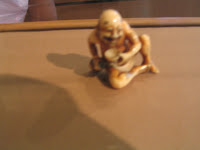Inside the pavilion were walls with hangings of Zen Buddhist art, mostly in the form of calligraphy. Now, I've gleaned from a few Chinese (Yimou) and Japanese (Kurosawa) films that in those cultures calligraphy is considered high art and is closely associated with concentration and meditation. On confronting the real thing, I couldn't make head or tail out of it. Moreover, some of the calligraphy looked like careless squiggles. Civilized gults would describe the experience as chukkal . After reading the more accessible descriptions could eventually make out a little bit of the idea of conveying emotion, instruction, warning, beauty through the shape, stress, form in the calligraphy letters. I will now try and convey the general idea behind the art with an example. There was one piece with stylized letters which translate to "Seas and Mountains". After staring at length, I felt that the artist had captured through the composition of these letters the turbulence of the seas and the loftiness of mountains. Decide for yourself from the picture below. (Click on pictures to enlarge)
Daruma (Bodhidharma), the Indian monk
who introduced Zen Buddhism to China.
The penetrating look reminds followers to
remain steadfast in their quest for enlightenment.

Calligraphy samples, the one on the right is titled
"Seas and Mountains". A note below commends the
"compositional genius".

Next were historical artifacts through the centuries, few of them dated 2000 B.C. This date made me uncomfortable and I said "too thoujen beecee" very many times.

Rounding up the Pavilion experience was a display of printmaking artwork by Saito Kiyoshi.
As we walked out the Pavilion, a small gallery caught the eye and the thought was, "might as well walk through". Netsuke miniature art is unlike anything I've seen before! The amount of detail, the precision, the playfulness, the perfection - really it is beyond words. Unfortunately the photos did not come out as well. A few samples:
After this and coffee, we went through rooms and rooms of European art through the centuries. I was too tired by now to be completely interested in everything, but work by the prolific sculptor Rodin and an Egyptian mummy were the highlights. In the Modern and Contemporary Art building was a most baffling exhibition of arrangements consisting wholly of fluorescent lights of various colors by Dan Flavin. Very interesting. Also, to me, very incomprehensible. Check out the online slideshow here (the explanations help, but only a little). Coming out, we walked into an open air jazz concert, a first ever experience.
LA will see more of me.







